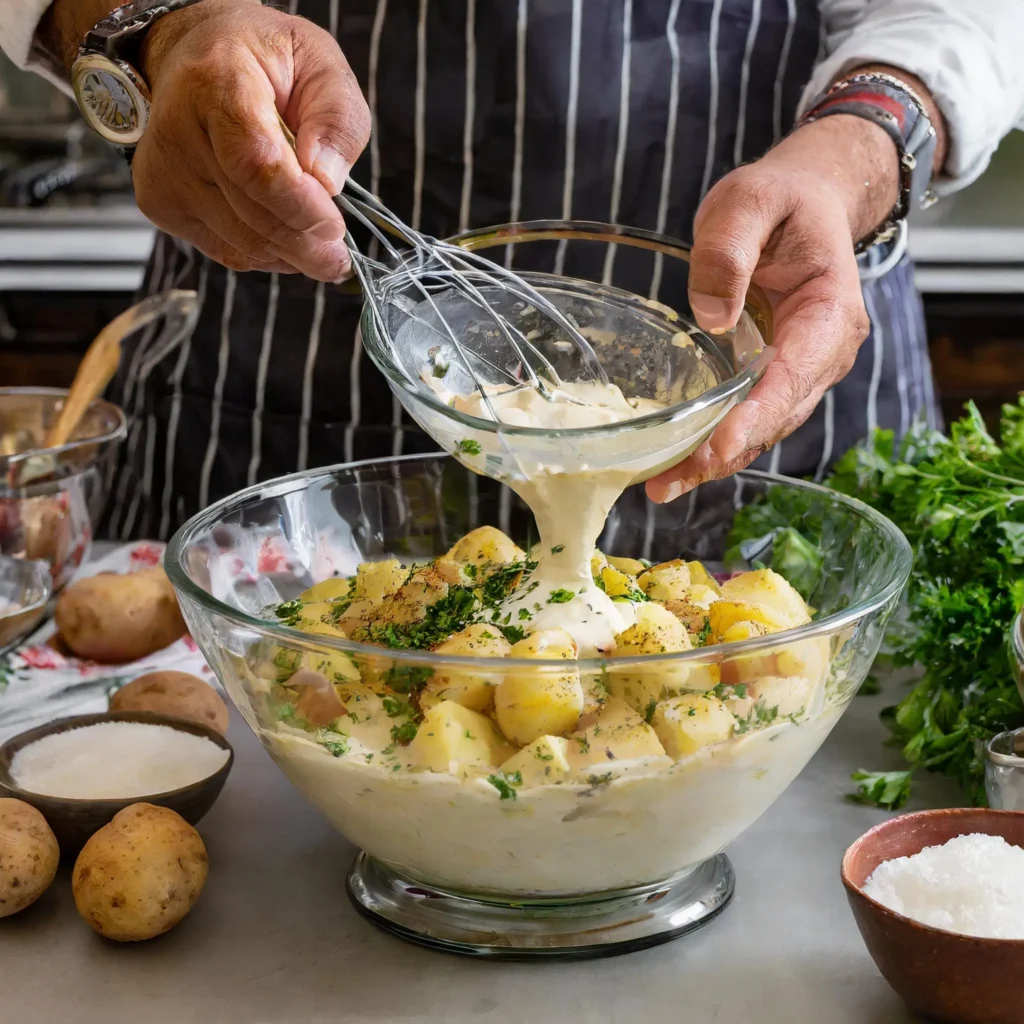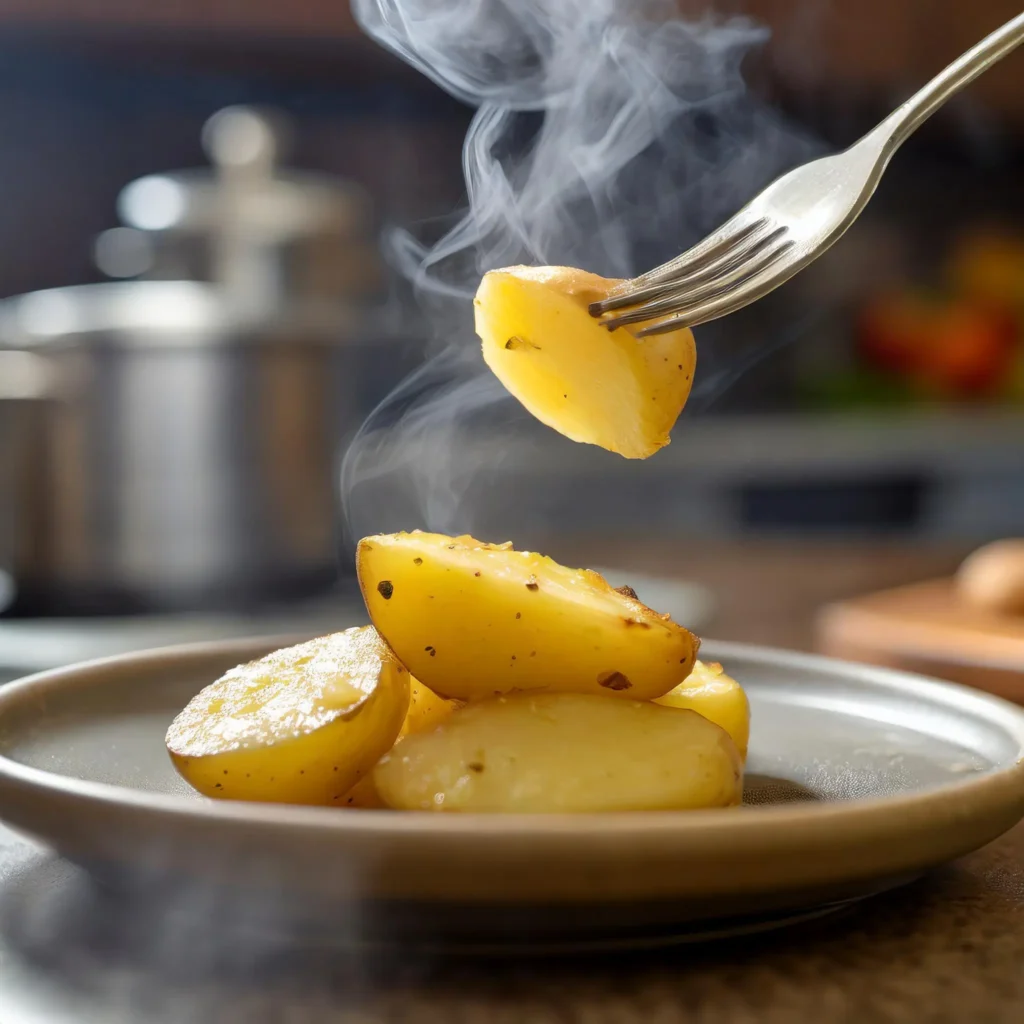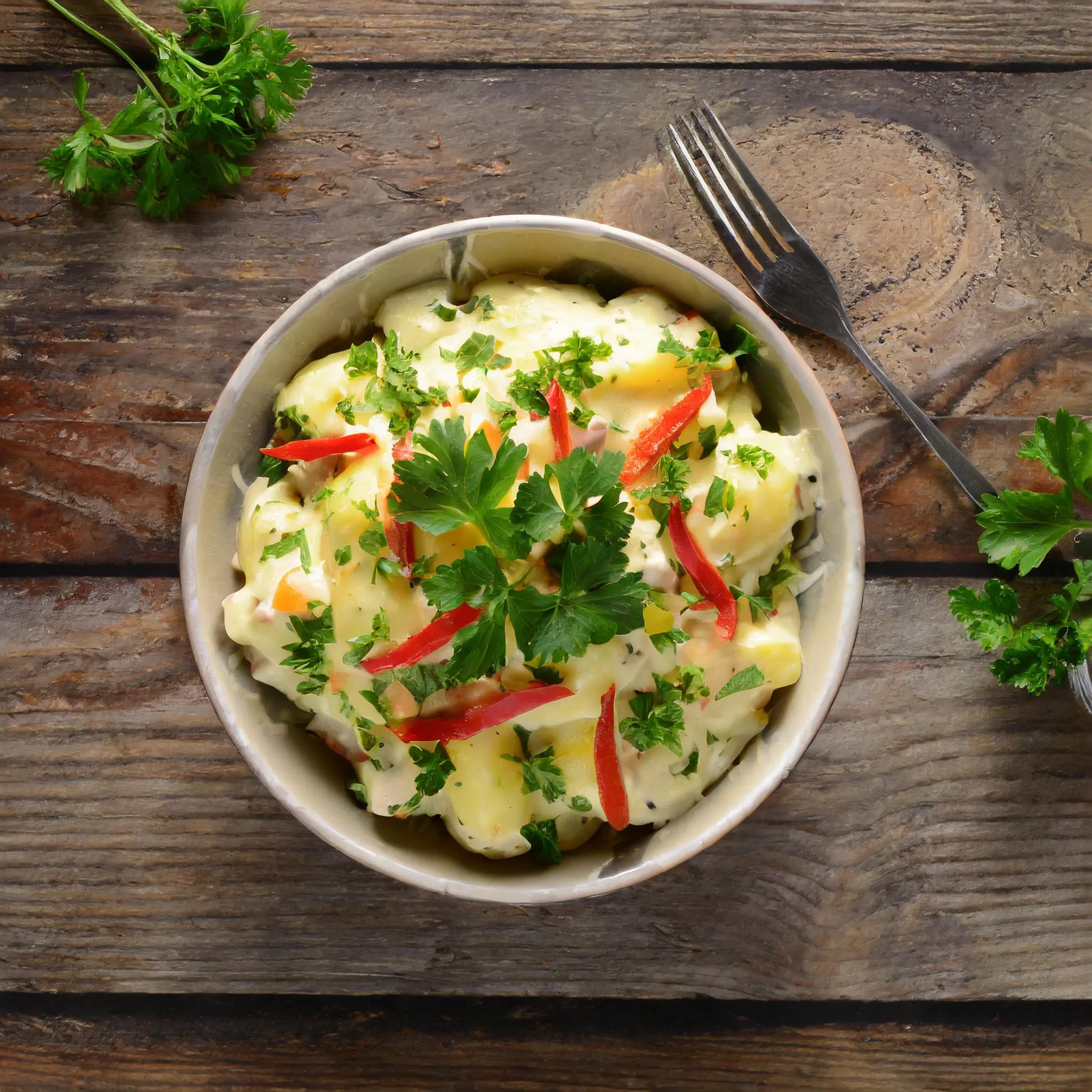Introduction
Potato salad is a classic dish that has graced countless tables, from summer barbecues to holiday feasts. Known for its creamy texture and versatile flavors, potato salad is a crowd-pleaser that suits nearly every occasion. However, preparing potato salad the traditional way can sometimes be time-consuming, especially when boiling the potatoes on a stovetop. Enter the cooker a game changer in the world of potato salad.
Table of contents
Ingredients for Cooker Potato Salad
When it comes to crafting the perfect potato salad, the ingredients you choose play a vital role. From the type of potato to the mix-ins and dressings, every component contributes to the dish’s overall taste and texture. Here’s a comprehensive guide to selecting and preparing the ingredients for a cooker potato salad.
Choosing the Right Potatoes
The star of any potato salad is, of course, the potato. The type of potato you choose can drastically affect the texture and flavor of your salad. Here’s a breakdown of popular choices:

1. Waxy Potatoes
Waxy potatoes, such as red potatoes and fingerlings, are a top choice for potato salad due to their firm texture and low starch content. These potatoes hold their shape well during cooking, making them ideal for salads where chunks are preferred.
2. All-Purpose Potatoes
Potatoes like Yukon Gold offer a balance between waxy and starchy varieties. They have a creamy texture and a buttery flavor, making them versatile for both traditional and creative potato salad recipes.
3. Starchy Potatoes
Russet potatoes are high in starch and tend to break apart when cooked. While they can be used for a creamier potato salad, they may require gentler handling to avoid a mushy texture.
Tip: Whichever type you choose, aim for uniform potato sizes to ensure even cooking in the cooker.
Additional Ingredients for Flavor
Potato salad isn’t just about potatoes—it’s the supporting ingredients that make the dish shine. Below are the essential and optional add-ons to consider:
Essential Ingredients:
- Mayonnaise or Dressing Base: The creamy foundation for classic potato salads.
- Hard-Boiled Eggs: Chopped eggs add protein and a velvety texture.
- Celery: Provides a crisp bite for contrast against the creamy potatoes.
- Onion: Red onions, green onions, or chives add a tangy flavor.
- Vinegar or Mustard: Balances richness with a hint of tang.
Optional Ingredients for a Flavor Boost:
- Herbs: Fresh parsley, dill, or cilantro enhance freshness.
- Pickles or Relish: Add a tangy crunch to each bite.
- Spices: Paprika, garlic powder, or black pepper for seasoning.
- Cheese: Shredded cheddar or crumbled feta for a gourmet touch.
- Bacon: Crispy bacon bits for a smoky, salty element.
Preparing Ingredients for Success
1. Cleaning and Peeling Potatoes
- Wash the potatoes thoroughly to remove dirt and debris.
- Peeling is optional, depending on the recipe and potato type. Skins can add texture and nutrients.
2. Prepping Vegetables and Add-Ins
- Dice vegetables uniformly for consistent texture.
- Hard-boil eggs in advance, cool them in ice water, and peel before chopping.
3. Choosing the Dressing
The dressing ties the salad together. For a traditional flavor, use a mayonnaise-based dressing. For lighter options, Greek yogurt or vinaigrettes can work wonders.
By preparing these ingredients and choosing complementary flavors, your cooker potato salad will be well on its way to becoming a flavorful masterpiece.
Step-by-Step Cooker Potato Salad Recipe
Making potato salad using a cooker is both efficient and straightforward. By following these step-by-step instructions, you’ll achieve perfectly cooked potatoes and a flavorful salad that’s sure to impress. Let’s dive into the details!

Preparing the Potatoes
1. Wash the Potatoes
- Rinse the potatoes under cold water to remove dirt and debris.
- Use a vegetable brush if necessary, especially for unpeeled potatoes.
2. Peel (Optional) and Cut
- Decide whether to peel the potatoes. Leaving the skin on can add texture and nutrients, especially for red or Yukon Gold potatoes.
- Dice the potatoes into uniform chunks (around 1–1.5 inches) for even cooking.
3. Soak in Water (Optional)
- If time permits, soak the cut potatoes in cold water for 15–30 minutes. This removes excess starch, preventing the potatoes from becoming too sticky during cooking.
Cooking the Potatoes in a Cooker
1. Using a Pressure Cooker
- Place a steamer basket or trivet in the pressure cooker. Add 1–2 cups of water to the pot.
- Arrange the potato chunks evenly in the steamer basket to ensure uniform cooking.
- Set the pressure cooker to manual/high pressure and cook for 5–8 minutes, depending on the potato type and chunk size.
- Perform a quick release to prevent overcooking, then carefully remove the potatoes and let them cool. (Cooker Potato Salad)
2. Using a Slow Cooker
- Add potatoes to the slow cooker along with ½ cup of water or broth for steaming.
- Cook on high for 2–3 hours or low for 4–6 hours, checking for tenderness with a fork.
- Drain any excess liquid and allow the potatoes to cool before assembling the salad.
3. Checking for Doneness
- Test the potatoes by piercing them with a fork or knife. They should be tender but not falling apart.
- Overcooked potatoes can become mushy, so keep a close eye on cooking times.
Mixing and Adding Ingredients
1. Prepare the Dressing
- In a small bowl, whisk together your dressing base (e.g., mayonnaise, yogurt, or vinaigrette) with seasonings. Common ingredients include:
- Mustard for tanginess.
- Vinegar or Lemon Juice for acidity.
- Salt and Pepper to taste.
2. Combine the Potatoes and Mix-Ins
- Place the cooled potatoes in a large mixing bowl.
- Gently fold in the dressing, ensuring all pieces are evenly coated.
- Add mix-ins such as chopped celery, onions, pickles, or herbs, stirring gently to maintain the potato chunks.
3. Chill Before Serving
- Cover the bowl and refrigerate the Cooker Potato Salad for at least 1–2 hours to let the flavors meld.
- For a last-minute serving, place the salad in the freezer for 15 minutes to cool quickly.
Final Touches
- Garnish: Top with fresh herbs (like dill or parsley) or a sprinkle of paprika for visual appeal.
- Taste Test: Adjust seasoning if needed before serving.
- Serve Cold or at Room Temperature: Potato salad is best enjoyed when cool, making it a refreshing addition to any meal.

By following these steps, you’ll create a potato salad that’s creamy, flavorful, and perfectly cooked. This method is ideal for both beginners and experienced cooks looking to save time with a cooker.
Heading 2: Pairing Suggestions for Cooker Potato Salad
Potato salad is a versatile dish that pairs beautifully with a wide range of meals. Whether you’re planning a backyard barbecue, a picnic, or a formal dinner, here are some delicious ideas to complement your cooker potato salad.
Heading 3: Barbecue Favorites
Potato salad is a classic side dish for grilled and smoky flavors. Pair it with these barbecue staples for a crowd-pleasing meal:
- Grilled Chicken: The creamy potato salad balances the charred, juicy flavors of barbecued chicken.
- Ribs or Pulled Pork: Tangy barbecue sauces and tender meat go perfectly with the rich texture of potato salad.
- Grilled Vegetables: Zucchini, bell peppers, and asparagus add freshness and balance to your plate.
Heading 3: Picnic and Lunch Pairings
For a casual outdoor meal or a quick lunch, potato salad is an ideal choice:
- Sandwiches: Pair it with deli classics like turkey, ham, or veggie sandwiches for a hearty meal.
- Wraps: Fresh tortilla wraps with chicken, avocado, or hummus complement the creaminess of potato salad.
- Cold Cuts and Cheese: Serve potato salad with a charcuterie platter for a no-cook meal.
Heading 3: Seafood and Light Proteins
Potato salad’s versatility extends to seafood and lighter proteins:
- Grilled Salmon: The creamy texture of the salad pairs well with the rich, flaky fish.
- Shrimp Skewers: Serve chilled potato salad alongside garlicky or lemony shrimp for a refreshing combo.
- Egg Dishes: Potato salad and deviled eggs or frittatas make a great brunch or potluck pairing.
Heading 3: Vegetarian and Vegan Options
For plant-based meals, potato salad is an excellent side dish:
- Veggie Burgers: Add a potato salad side to a hearty lentil or black bean burger.
- Roasted Vegetables: Sweet potatoes, Brussels sprouts, and carrots complement the creaminess of potato salad.
- Grain Bowls: Combine potato salad with quinoa, couscous, or farro for a filling vegetarian meal.
Heading 3: International Pairings
Explore global flavors that work beautifully with potato salad:
- German Sausages: Serve warm potato salad with bratwurst or kielbasa for a traditional pairing.
- Mediterranean Platters: Pair potato salad with hummus, olives, and pita bread for a Mediterranean-inspired meal.
- Spicy Dishes: Balance the heat of spicy tacos, curries, or jerk chicken with a creamy potato salad side.
Heading 3: Beverage Pairings
Round out your meal with the perfect drink:
- Iced Tea or Lemonade: Light, refreshing drinks complement the richness of potato salad.
- White Wine: Crisp white wines like Sauvignon Blanc or Chardonnay pair well with creamy salads.
- Craft Beer: A light ale or pilsner balances the heartiness of the dish.
FAQ
To help you perfect your cooker potato salad and address common concerns, here are answers to frequently asked questions. These insights will guide you through substitutions, storage, and preparation tips.
Can I use sweet potatoes instead of regular potatoes?
Yes, sweet potatoes can be an excellent substitute for regular potatoes, adding a unique flavor and vibrant color to your salad.
Preparation Tips:
- Sweet potatoes cook faster than regular potatoes, so monitor them closely in the cooker to prevent overcooking.
- Pair sweet potatoes with complementary flavors like lime juice, black beans, and a tangy vinaigrette for a Southwest-inspired salad.
Considerations:
- Sweet potatoes have a naturally softer texture, so they’re better suited for salads with a creamy dressing or mashed consistency.
How long does Cooker Potato Salad last?
Potato salad typically lasts 3–5 days in the refrigerator when stored properly.
Storage Tips:
- Use an airtight container to preserve freshness and prevent odors from other foods in the fridge from seeping in.
- Label the container with the preparation date to keep track of freshness.
Safety Note:
- Avoid leaving Cooker Potato Salad at room temperature for more than 2 hours (or 1 hour in hot weather) to prevent bacterial growth.
Can I freeze potato salad?
Freezing potato salad is not recommended, especially if it contains mayonnaise or dairy-based dressings. These ingredients tend to separate and lose their creamy texture when thawed.
Alternative Approach:
- Freeze the cooked, plain potatoes and prepare the dressing fresh when ready to serve.
- For vinegar-based potato salads, freezing may work better as the dressing components are less prone to separation.
What’s the best way to make Cooker Potato Salad ahead of time?
Potato salad is an excellent make-ahead dish, as the flavors improve with time.
Preparation Tips:
- Prepare the salad up to 24 hours in advance and store it in the refrigerator.
- Keep garnishes like herbs and bacon bits separate until serving to maintain freshness and texture.
Quick Trick:
- If making the salad on the same day, chill it in the freezer for 15–20 minutes to speed up the cooling process before serving.
Can I skip peeling the potatoes?
Yes, you can skip peeling the potatoes, especially if you’re using thin-skinned varieties like red potatoes or Yukon Gold.
Advantages:
- Leaving the skin on adds texture, nutrients, and a rustic appearance.
- It saves time and reduces food waste.
When to Peel:
- Peel potatoes if you prefer a smoother texture or if using thicker-skinned varieties like Russets.
What’s the healthiest dressing option for Cooker Potato Salad?
For a lighter, healthier version of potato salad, consider alternative dressings:
Options:
- Greek yogurt: High in protein and creamy, with fewer calories than mayonnaise.
- Olive oil and lemon vinaigrette: Perfect for a fresh and zesty Mediterranean-style salad.
- Mashed avocado: A dairy-free, nutrient-rich option that adds creaminess.
Tips:
- Add fresh herbs, garlic, or Dijon mustard to enhance flavor without extra calories.
- Use low-fat or vegan mayonnaise as a substitute for traditional mayo.
These FAQs cover the most common queries about making and customizing potato salad. By keeping these tips in mind, you’ll feel confident experimenting with your recipes and ensuring delicious results every time.
Conclusion
Cooker Potato Salad is a timeless dish that offers endless possibilities for customization and flavor. By using a cooker, you can streamline the preparation process and ensure perfectly cooked potatoes every time. Whether you’re making a classic mayonnaise-based version, a tangy mustard twist, or a light vegan alternative, the key lies in selecting the right ingredients, using the proper tools, and mastering techniques for balance and consistency.

